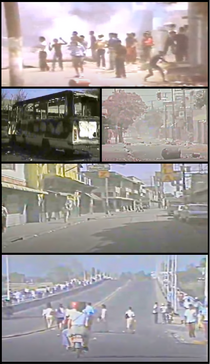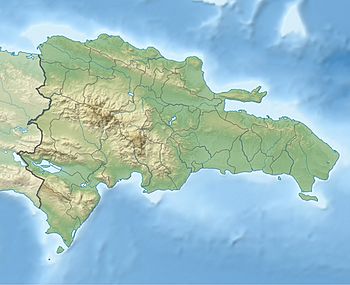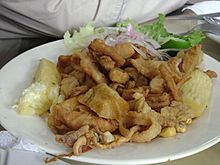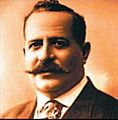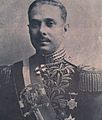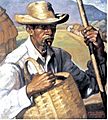Dominican Republic facts for kids
Quick facts for kids
Dominican Republic
República Dominicana (Spanish)
|
|
|---|---|
|
|
|
|
Motto: "Dios, Patria, Libertad" (Spanish)
"God, Homeland, Freedom" |
|
|
Anthem: Quisqueyanos valientes
Valiant Quisqueyans |
|
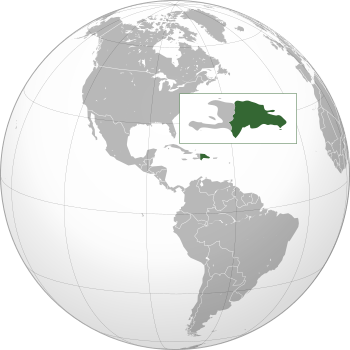 |
|
| Capital and largest city
|
Santo Domingo 18°27′N 69°56′W / 18.450°N 69.933°W |
| Official languages | Spanish |
| Other languages | See below |
| Ethnic groups
(2022)
|
|
| Religion
(2020)
|
|
| Demonym(s) | Dominican Quisqueyan (colloquial) |
| Government | Unitary presidential republic |
| Luis Abinader | |
| Raquel Peña | |
| Legislature | Congress |
| Senate | |
| Chamber of Deputies | |
| Formation | |
|
• Ephemeral Independence
|
1821–1822 |
|
• First Republic
|
1844–1861 |
|
• Second Republic
|
1865–1916 |
|
• Third Republic
|
1924–1965 |
|
• Fourth Republic
|
1966–present |
| Area | |
|
• Total
|
48,671 km2 (18,792 sq mi) (128th) |
|
• Water (%)
|
0.7 |
| Population | |
|
• 2025 estimate
|
|
|
• Density
|
220/km2 (569.8/sq mi) (65th) |
| GDP (PPP) | 2025 estimate |
|
• Total
|
|
|
• Per capita
|
|
| GDP (nominal) | 2025 estimate |
|
• Total
|
|
|
• Per capita
|
|
| Gini (2022) | ▼ 37 medium |
| HDI (2023) | high · 89th |
| Currency | Dominican peso (DOP) |
| Time zone | UTC-04:00 (AST) |
| Date format | dd/mm/yyyy or dd-mm-yyyy |
| Driving side | right |
| Calling code | +1 |
| ISO 3166 code | DO |
| Internet TLD | .do |
|
Sources for area, capital, coat of arms, coordinates, flag, language, motto and names:
For an alternate area figure of 48,730 km2 (18,810 sq mi), calling code 809 and Internet TLD: |
|
The Dominican Republic (in Spanish: República Dominicana) is a country located on the Caribbean island of Hispaniola. The other country on this island is Haiti. The capital and largest city is Santo Domingo. The main language spoken here is Spanish.
This country was once part of the Spanish Empire. Later, in the 19th century, France, Spain, and Haiti took turns controlling it. It became independent but was occupied by the United States from 1916 to 1924. Today, the Dominican Republic is a democratic republic led by a president. The country has a tropical climate, but cool winds from the Atlantic Ocean (called trade winds) and mountains change the weather in some areas.
Contents
History of the Dominican Republic
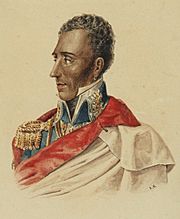

Christopher Columbus found the island of Hispaniola on December 5, 1492. He first saw a part of what is now the Dominican Republic on January 4, 1493. He named a headland Monte Cristi, which is now called El Morro.
On his second trip to America, Columbus started the first European city in the continent, La Isabela. It was near the modern city of Puerto Plata. Later, Bartholomew Columbus founded Santo Domingo. This is the oldest European city that has been continuously lived in since it was built.
From Santo Domingo, many Spaniards went to explore and settle other islands like Cuba, Jamaica, and Puerto Rico. Because Cuba was closer to the mainland, many people moved there from Hispaniola. This made the island's population grow very slowly.
In 1697, Spain gave the western part of the island to France. The island then had two different colonies: the French Saint-Domingue and the Spanish Santo Domingo. In 1795, France gained control of the entire island. However, Haiti became independent very quickly. So, France could only control the eastern part for a short time. In 1809, the French gave the old colony of "Santo Domingo" back to Spain.
On December 1, 1821, the Spanish governor José Núñez de Cáceres announced independence from Spain. The new country was called Independent State of Spanish Haiti. But on February 9, 1822, the Haitian army took control. They stayed for 22 years.
Juan Pablo Duarte started a secret group, La Trinitaria, to help Dominicans become free. The Haitian control ended on February 27, 1844. The people in the eastern part of Hispaniola created a new country called República Dominicana (Dominican Republic).
From 1861 to 1865, Spain took control again. On August 16, 1863, the Restoration War began. Dominicans fought to be free once more. This war ended in 1865 when the Spanish left. The Dominican Republic became an independent country again.
The United States occupied the country from 1916 to 1924. In 1930, Rafael Trujillo became president after a coup d'état. Trujillo was a very strict leader. He was killed in 1961.
After Trujillo's death, Juan Bosch was elected president in 1962. He was the first elected president since 1930. But Bosch was in power for only seven months. In 1965, there was a civil war. People fought over whether Bosch should return to power.
On April 28, 1965, U.S. President Lyndon Johnson sent troops to Santo Domingo. This was to prevent communists from taking over. Forces from the OAS (Organization of American States) also joined. These troops stayed for over a year. They left after elections in 1966. Joaquín Balaguer won these elections. He had been Trujillo's last president. Balaguer remained president for 12 years.
In 1978, Antonio Guzmán Fernández became president. He was from the opposition party. Balaguer became president again in 1986. He was re-elected in 1990 and 1994.
In 1996, Leonel Fernández won the election. He was the first from the Dominican Liberation Party (PLD) to win. This party was started by Bosch in 1973. Fernández's time as president saw a fast-growing economy. The economy grew by 7.7% each year. Unemployment went down, and prices were stable.
His government worked to make the justice system more modern. They created an independent Supreme Court. They also improved other government parts. The country reconnected with Cuba. They signed a Free Trade Agreement with Central America. This led to the DR-CAFTA agreement.
In 2000, Hipólito Mejía of the PRD won the election. This period had some economic challenges. The Dominican Republic joined a US-led group during the 2003 Iraq War. They did not have any casualties.
In 2008, Fernández was elected for a third time. Fernández and the PLD are known for bringing new technology to the country. However, his governments have also faced accusations of corruption.
Danilo Medina of the PLD was elected president in 2012. He was re-elected in 2016. During his time, there was more crime and government corruption. The justice system was also weak. These issues sometimes overshadowed his work.
Luis Abinader became president in the 2020 election. This happened after protests against Medina's government. It ended 16 years of the PLD being in power. In May 2024, President Luis Abinader won a second term. His strong policies on migration from Haiti were popular with voters.
Government and Politics
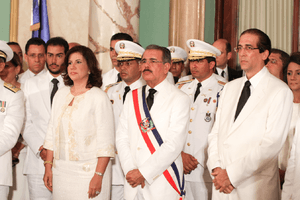
The Dominican Republic is a democratic republic led by a president. The government has three main parts:
- The Executive branch includes the President, Vice President, and Ministers. The President is the head of the country and the government. They are elected every 4 years and choose the Ministers.
- The Legislative branch makes the laws. It is called the Congress and is in Santo Domingo. The Congress has two groups: the Senate (32 members) and the Chamber of Deputies (178 members).
- The Judicial branch includes the country's courts, like the Supreme Court of Justice.
Political Parties
There are three main political parties in the Dominican Republic:
- PRD: The Dominican Revolutionary Party (Spanish: Partido Revolucionario Dominicano). This party has some socialist ideas. It was founded in 1939 in Havana, Cuba. It started in the Dominican Republic in 1961.
- PRSC: The Social Christian Reformist Party (Spanish: Partido Reformista Social Cristiano). This is a conservative party. Joaquín Balaguer founded it in 1964. He was president from 1966-78 and 1986-96.
- PLD: The Dominican Liberation Party (Spanish: Partido de la Liberación Dominicana). When it started in 1973, it had some socialist ideas. Now, it is a liberal party.
Geography and Climate
The Dominican Republic has several mountain ranges. The four main ones, from North to South, are:
- Cordillera Septentrional (Northern mountain range), near the Atlantic Ocean.
- Cordillera Central (Central mountain range). This range continues into Haiti. The highest mountains in the West Indies are here. Pico Duarte, at 3,087 meters, is the tallest. Many important rivers start in this range.
- Sierra de Neiba.
- Sierra de Bahoruco, also known in Haiti as Massif de la Selle.
Between these mountains, there are several important valleys:
- The Cibao Valley is the largest and most important valley. It stretches from North Haiti to Samaná Bay.
- The San Juan Valley and Plain of Azua are large valleys south of the Cordillera Central.
- The Hoya de Enriquillo or Neiba Valley is a very dry valley south of Sierra de Neiba.
- Llano Costero del Caribe (Caribbean Coastal Plain) is in the southeast. This large prairie is east of Santo Domingo. Many sugar cane farms are found here.
Other smaller valleys are Constanza, Jarabacoa, Bonao, and Villa Altagracia.
The four most important rivers are Yaque del Norte, Yuna, Yaque del Sur, and Ozama. The largest lake is Lake Enriquillo, in the Hoya de Enriquillo.
The country has a tropical climate. This means it's generally warm. But mountains and trade winds (winds from the northeast) can change the temperature. Near the sea, the average temperature is about 25 °C. In the highest mountains, it can get as cold as 0 °C in winter.
There are two wet seasons: April to June and September to November. The driest time is from December to March. Rainfall varies a lot. Eastern areas like the Samaná Peninsula get over 2,000 mm of rain a year. But the southwest (Hoya de Enriquillo) gets less than 500 mm.
From June to November, hurricanes are common. They can cause a lot of damage on the island.
People and Cities
The Dominican Republic had about 11.4 million people in 2024. This means there are about 220 people per square kilometer.
About 64% of Dominicans live in cities and towns. Most people (87%) aged 15 or older can read and write.
The two largest cities are Santo Domingo and Santiago. Santo Domingo is the capital city. Santiago is in the Cibao Valley.
Provinces
The Dominican Republic is divided into 31 provinces. The capital, Santo Domingo de Guzmán, is in the Distrito Nacional. This area is like a province and has its own Senator.
The provinces are:
Economy
The Dominican Republic has a mixed economy. This means it uses different ways to make money. The main activities are agriculture, services (like tourism and finance), trade, and money sent from Dominicans living abroad.
Farming, especially sugar cane, used to be the biggest part of the economy. Now, tourism and manufacturing are more important. Manufacturing happens in "free zones". In these zones, industries do not pay taxes, and their products are sent to other countries.
Mining is also important. They mainly mine ferronickel (a mix of nickel and iron) and gold.
The Dominican Republic faces challenges with poverty. In 2012, many people lived below the poverty line. Also, wealth is not shared equally. The richest 10% of people earn almost 40% of the country's income.
Culture
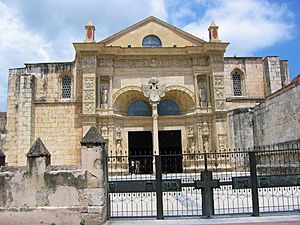
The culture of the Dominican Republic is a blend of different influences. These include Taíno (the native people), African, and European (mostly Spanish) cultures.
Not many Taíno traditions remain in modern Dominican culture. However, many places still have Taíno names. Examples include Dajabón, Bánica, and Samaná. Also, many words for objects, plants, and animals come from Taíno. These words are now used in other languages. For example, canoa (canoe), hamaca (hammock), maíz (corn), and batata (sweet potato).
This mix of traditions created a culture known as Creole. This type of culture is common in many Caribbean countries.
Languages
In the Dominican Republic, Spanish is the main language. However, other languages are also spoken. These include Haitian Creole, Samana English, and Lucumi. Lucumi comes from the West African Yoruba language. Most Dominicans also speak a local way of Spanish called Dominican Spanish Creole.
Religions
The official religion is Roman Catholicism. But people are free to practice any religion they choose. Protestant groups are also important. They make up about 15% of the population.
Every year, there are big celebrations called fiestas patronales. These are Catholic events that honor the patron saints of towns and villages. This is a Spanish tradition. The celebrations include church services, parades, fireworks, and dancing.
African influences are very strong in Dominican culture. You can see this in the language, religion, food, and music. Some people also practice Dominican Voodoo or Santeria, and other African-based religions like Dominican Palo and Dominican Kongo religion.
Related Pages
- Dominican Republic at the Olympics
- Dominican Republic national football team
- List of rivers of the Dominican Republic
Images for kids
-
The Spanish Caribbean in 1600.
-
A map showing the border on Hispaniola after the Treaty of Aranjuez (1777).
-
Ramón Cáceres, a former president.
-
The United States Marine Corps landing in the Dominican Republic in 1916.
-
The flag of the United States over Ozama Fortress during the U.S. occupation (around 1922).
-
Rafael Trujillo led the country for 31 years (1930–1961).
-
Juan Bosch, the first democratically elected president after Trujillo's rule.
-
Leonel Fernández was president from 1996–2000 and 2004–2012.
-
Danilo Medina was president from 2012–2020.
-
Luis Abinader, the current president of the Dominican Republic since 2020.
-
The Constanza valley.
-
Mangroves in Los Haitises National Park.
-
View of Santo Domingo, the capital city.
-
Cabeza de Toro beach in Punta Cana.
-
27 de febrero avenue in Santo Domingo.
-
People in the town of Moca.
-
The Basilica Cathedral of Santa María la Menor, the oldest cathedral in the Americas.
-
A family of Japanese descent in Constanza.
-
A satellite image of the border showing deforestation in Haiti (left) compared to the Dominican Republic (right).
-
Dominicans and Haitians waiting for medical help from the U.S. Army Reserve.
-
Haitian workers being transported in Punta Cana.
-
Merengue and Bachata are music styles from the Dominican Republic. Here are two famous artists, Juan Luis Guerra and Romeo Santos.
-
Oscar de la Renta, a famous fashion designer from the Dominican Republic.
-
Albert Pujols, a famous baseball player from the Dominican Republic.
See also
 In Spanish: República Dominicana para niños
In Spanish: República Dominicana para niños




